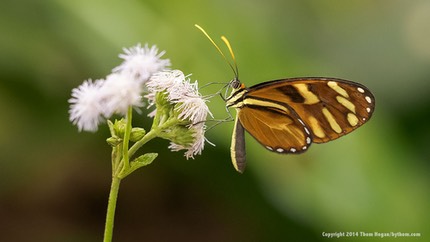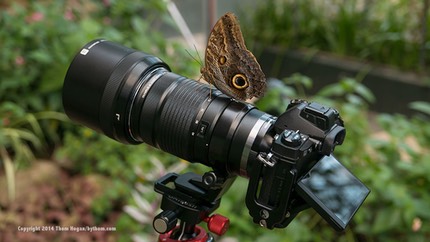
Over Christmas I decided to challenge my m4/3 gear: I took only m4/3 cameras and lenses to Costa Rica for a short wildlife-oriented trip. For those not familiar with Costa Rica, it has abundant bird life, large jungle forests in National Parks, and tends to be a fairly wet environment due to its mountainous terrain and position between the Pacific Ocean and the Caribbean. My target gear selection for such a trip would be: fast continuous autofocus, excellent low light capability, and strong weatherproofing.
Let’s get the good news out of the way first: weatherproofing is certainly a strength of most of the gear I brought on the trip and I found myself in mist, drizzle, rain, and even ocean/river/waterfall spray quite often. When it came to wet, my biggest problem was just keeping the front element of the lens clean. In general, I’d say that the gear I used probably would work in any environment where I could keep the lens clean.

So what gear was I using? Primarily the Olympus E-M1, 12-40mm f2.8, and 40-150mm f/2.8. I also brought the 60mm f/2.8 macro lens, and the Panasonic 7-14mm f/4 and 100-300m f/4.5-5.6. My backup body was an E-M10, and my convenience camera was a Panasonic LX-100. As I said: all m4/3 gear.

Another bit of good news is that all this makes for a remarkably small kit, one that was with me almost all the time. It also makes for a kit that can produce just about anything in terms of photography. After all, I’m 14-600mm equivalent overall.
So let’s get to the challenges of such a trip and how the m4/3 gear fared:

- Abuse — The Olympus E-M1 is rugged. Really rugged. With one exception: the viewfinder eyecup. From the earliest days of the Pen (E-P1) to the present cameras Olympus has had an eyecup that just has a tendency to fall off at all the wrong moments. And sure enough, I lost another eyecup on this trip. Olympus really needs to rethink what they’re doing here: the current designs simply don’t handle a one-side pressure at all well. When they get pushed—whether it be taking the camera in and out of the bag, brushing against something, or even in highly active use—the tendency is for the right side to pop out of its support and the entire piece flip off the camera. That tendency is so high that every time I get a new Olympus and see that they haven’t fixed that problem yet I buy a second eyepiece for the camera immediately. I know I’m going to lose the original. So far, my record with Olympus cameras on active trips is an average of one eyepiece lost per trip. Costa Rica was no exception.
- Autofocus — Birds are always a challenge for focus systems, and hummingbirds—of which Costa Rica has a plentiful supply—add another wrinkle with their constant start/stop motions. Their stop is short and the start is very rapid movement. But coupled with the typical birds in flight problems, this trip also had another: boat motion. In Tortuguero, for instance, we were in boats in the lagoons, and even if the bird is stationary, your boat generally isn’t. You can’t always use S-AF—especially with the focus transferred to the AE-L button (AF-On)—because by the time the image is taken the boat has moved a bit.
The biggest challenge I had with focus was finding a group of settings that worked for each situation I encountered. Unfortunately, that sometimes means grappling with the Olympus menu system, another thing that they need to fix. I missed a few opportunities when I decided that my autofocus configuration was not right for a new situation I encountered, and had to reassign an entire group of settings (as opposed to just changing focus modes, which can be done quickly). In general, I also found that the AF+MF magnify modes weren’t useful with all the motion I was dealing with (subject and boat). I just couldn’t dial in acuity fast enough. On the other hand, those modes were extremely useful when both I and the subject where more motionless.
Any continuous autofocus sequence I shot tended to suffer from in/out problems. A bird-in-flight shot might in focus, the next slightly out, the next slightly in, the next in, the next out again. My hit rate on continuous autofocus was decidedly lower than it is with my Nikon DSLRs in such situations. This led me to explore alternative strategies, including letting the bird fly (or drift) into focus and only taking one shot, for instance. In general, though, I just didn’t feel at DSLR autofocus levels when subjects or I were moving. On the other hand, in more static situations I tended to find getting precise focus easier than with a DSLR. - Battery — Most of the time I wasn’t in my snap away mode, though there were times when I was shooting for relatively long periods basically as fast as I could. Running that EVF for long periods of time tends to be a battery drainer, so I had probably two sessions that became multiple battery sessions. The good news is that the E-M1 is pretty good at battery handling, though it’s not DSLR like. Since I knew that in advance, I just brought lots of batteries and a multiple battery charger. One thing I want to point out: that’s not an Olympus charger. Olympus battery chargers tend to be amongst the slowest to recharge a battery (based on amps/hour) that I’ve ever seen for camera gear. The Watson chargers that B&H sells charge the same battery far faster in my experience. I’m sure there are other third party chargers that do, too. This isn’t something you should ignore in your planning. Sometimes you run through more batteries than you expect to and a slow charger can put you in a cycle of dwindling fresh batteries, especially if power is not present 100% of the time.
- Low Light — If you plan to go to Costa Rica for wildlife shooting, plan on needing ISO 3200 and 6400 often (many of the images shown here are at ISO 1600). On the other hand, you can encounter situations where you’re in sunny daylight, too. But given the ever changing weather, the intense forest cover, and the preferred locations of much of the wildlife, you’ll be shooting in far less than ideal conditions much of the time. Turtles sunning themselves on a log? Not a problem. Spider monkey at mid-tree in a dense forest? Problem. Green Heron that’s jumped back into the shoreline brush under the canopy? Big problem.
I really don’t like pressing the current m4/3 sensors above ISO 1600. Which is one of the reasons why I wanted that 40-150mm f/2.8 lens with me. I found that I could often get excellent results with a bit of compromise all around: a bit less focal length (300mm equivalent), ISO at 1600, careful handling of the camera, and picking moments and subjects with less motion, allowing me to push my shutter speed lower.
However, the Panasonic 100-300mm in many situations was more problematic. I found plenty of times where I really needed ISO 6400 to compensate for the f/5.6 I was shooting at, and I was still pressing shutter speeds to boundaries that were very marginal, at best. I threw away a lot of shots from this lens, and my keeper rate with it was low, not really because of any deficiency of the lens (other than it’s maximum f/5.6 at longer focal lengths).
The two people shooting with me were using full frame cameras, one Canon, one Nikon. They weren’t having the same low-light struggles I was, though both felt that they were pushing the limits in their ISO usage.
Did I come back with some good photos? Yes, I did. Did I come back with all the photos I wanted to? No I didn’t. Indeed, to do so I’d pretty much have to bring my Nikon DSLRs with faster long lenses (e.g. my 400mm f/2.8). But, of course that would be a far bigger and heavier kit.

Which brings me to a point that I’ve been making for years: cameras and lenses are tools to an end. Sometimes you need Tool X, sometimes you need Tool Y. Indeed, the reason why I started bringing Olympus m4/3 gear with me on safari in Africa was to be Tool Y when I wanted to leave Tool X intact (e.g. not change lenses in dusty environments). No camera system is going to do/be everything.
On this trip I wanted to travel light because it was part of a longer non-photography trip I was doing. Thus, I made compromise decisions right up front. I wanted a very small, light, portable set of gear and was willing to pass up some photo opportunities to get it. That’s exactly where mirrorless tends to excel these days. I didn’t give up a terrible amount with the m4/3 gear I carried, but I did give up something. It’s important for you to know, and be comfortable with, those compromises if you want to be satisfied with your gear.

Overall, the m4/3 gear performed pretty much as I expected it to. Thus, I’m happy. But this notion that mirrorless cameras do everything is not correct. You give up something for the smaller size and weight. In this instance, I gave up fast moving subjects in low light. Make sure you know what you’re giving up and what you’re getting in return.

